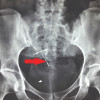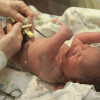
 IJCP Editorial Team
IJCP Editorial Team
Neonatal Morbidities in Infants Born Late Preterm at 35-36 Weeks of Gestation
Preterm infants, born at 35-36 weeks, are often admitted to a level I unit (well-newborn maternity wards). However, they may still be physiologically immature.
Infants born late preterm have a higher risk of neonatal mortality than their term (37-41 weeks) counterparts. Additionally, they also have a higher risk of neonatal morbidity, with an increased health care burden. This risk in infants born at 35-36 weeks compared with term infants is yet to be studied briefly on a national population level.
A recent study assessed the risk for neonatal morbidities among infants born late preterm at 35-36 gestational weeks, early term (37-38 weeks), and late-term (41 weeks) infants, compared with full-term (39-40 weeks) infants.
This nationwide population-based cohort study was carried out in 1,650,450 non-malformed liveborn singleton infants born at 35-41 weeks between 1998 and 2016 in Sweden. The relative risks for low Apgar score (0-3) at 5 minutes; respiratory, metabolic, infectious, and neurologic morbidities; and severe neonatal morbidity (composite outcome) were adjusted for maternal, pregnancy, delivery, and infant characteristics.
The results were as follows-
- Infants born at 35-36 weeks showed higher adjusted relative risks and proportions for metabolic morbidity, respiratory morbidity, severe neonatal morbidity, infectious morbidity, neurologic morbidity, and a low Apgar score, than the infants born at 39-40 weeks.
- The risks for respiratory, severe neonatal morbidity, infectious, neurologic morbidities, and low Apgar score were found to be greatest at 35 weeks, which slowly decreased until 39 weeks, and then further increased during 39-41 weeks.
Thus, infants born late preterm at 35-36 weeks of gestation possess a greater risk of neonatal morbidities, however, the absolute risks for severe neonatal morbidities are low. Hence there is a need of preventing late preterm delivery to decrease the burden of neonatal morbidity and help professionals and families with a better risk assessment.
Source: Mitha A, Chen R, Altman M, Johansson S, Stephansson O, Bolk J. Neonatal Morbidities in Infants Born Late Preterm at 35-36 Weeks of Gestation: A Swedish Nationwide Population-based Study. The Journal of Pediatrics. 2021;233:43-50. DOI:https://doi.org/10.1016/j.jpeds.2021.02.066

IJCP Editorial Team
Comprising seasoned professionals and experts from the medical field, the IJCP editorial team is dedicated to delivering timely and accurate content and thriving to provide attention-grabbing information for the readers. What sets them apart are their diverse expertise, spanning academia, research, and clinical practice, and their dedication to upholding the highest standards of quality and integrity. With a wealth of experience and a commitment to excellence, the IJCP editorial team strives to provide valuable perspectives, the latest trends, and in-depth analyses across various medical domains, all in a way that keeps you interested and engaged.













Please login to comment on this article